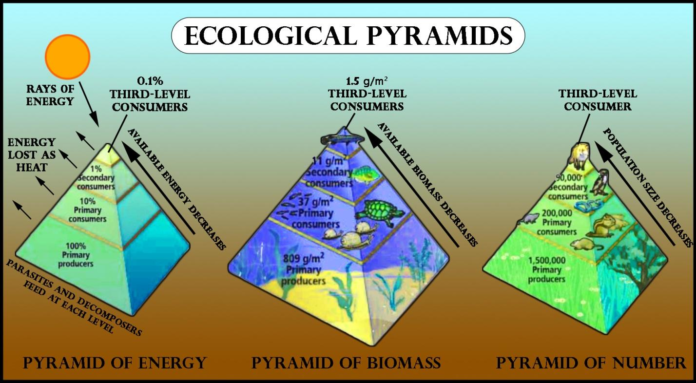Graphical representation of different ecological pyramids at different trophic levels in the ecosystem is known as pyramids. Number, biomass and energy are different parameters. Charles Elton formed the first pyramid. It is known as the Eltonian pyramids.
In pyramids, the base, middle, and top tier represent producer, herbivore and carnivore in the ecosystem.
Food chain
Organisms are dependent on each other for food. Different organisms are arranged in series in which the food energy is transferred through repeated eating and being eaten. This is known as the food chain. Food material or energy is transferred from one trophic level to another.
Four trophic levels are present in an ecosystem as energy decreases from one trophic level to another.
- First trophic level includes the producers.
- Second trophic level includes the primary consumers.
- Third trophic level includes the secondary consumers.
- Fourth trophic level includes top consumers.
In a highly complex ecosystem, there are 5 trophic levels. Tertiary consumers are present in between the secondary consumers and top consumers. The top consumer forms fifth trophic level.
- Flow of energy in a food chain is unidirectional.
- Shorter food chains will give more energy.
- Decomposers are not the member of food chain.
Types of food chain
There are three types of food chain-
- Grazing food chain/predator food chain
- Most common food chain.
- Chain begins from producers (plants), and smaller organisms are then in successive order from small to big organisms.
- For example, the Aquatic ecosystem and the Grassland ecosystem.
- Parasitic food chain
- This type of food chain starts from producers but goes from big organisms to smaller organisms in successive order.
- For example, the Tree ecosystem.
- Detritus food chain/saprophytic food chain
- This type of food chain begins when dead organic matter decompose.
- Bacteria and fungi are primary producers in detritus food chain.
- Energy flow is very slow in the detritus food chain.
Food web
When many food chains are linked to each other on different trophic levels, they form a food web. Transfer of energy in the food web is unidirectional. Members in a particular trophic level obtain food according to their taste and choice. The more complex the food chain, the more stable or permanent the ecosystem. This ecosystem with simple food webs is not very stable.
Types of Ecological Pyramids
There are three types of pyramids-pyramids of number, pyramid of biomass and pyramid of energy.
- Pyramid of number
- In the pyramid of numbers, each trophic level represents the number of individuals.
- Pyramid of numbers is mostly upright as producers are maximum in number.
- As we move to the next trophic level, herbivore and carnivore, the number of organisms decreases.
- In grassland and aquatic ecosystems, the pyramid of numbers is upright.
- But in the tree ecosystem, the pyramid of numbers is inverted. This is also known as a parasitic ecosystem as birds (herbivores) depend on the tree (producer), and parasites (consumer) depend on birds, so with increase in the number of trophic levels, the number of the organisms increases.
- Maximum number of producers are found in aquatic ecosystems. Availability of food determines the number of organisms at each trophic level.
- Pyramid of Biomass
- Total amount of biomass present at each trophic level represents the pyramid of biomass.
- In the forest and tree ecosystem, biomass pyramids are upright or erect.
- Pyramid of biomass in the aquatic ecosystem is inverted as producers are microorganisms and they produce very little biomass.
- Pyramid of energy
- It represents the energy at different trophic levels.
- Pyramid of energy is always upright or erect as the energy decreases at each trophic level.
- Pyramids of energy follow the 10 percent law of Lindeman. According to this law, 90 percent of energy obtained by organisms at each trophic level is utilised in different metabolic reactions, and only 10 percent is passed to the next trophic level. So, 90 percent is consumed at each trophic level, and therefore top consumers like lions, etc., are ecologically weakest but physically very strong.
- Pyramids of energy represent an ecosystem’s productivity and the transfer of production in the ecosystem.
Limitations of Ecological pyramids
- The same species is not considered if it is present in two or more trophic levels.
- It does not include the food web.
- Saprophytes are not included in ecological pyramids.
Standing crop
Standing crop is defined as the total amount of living organic matter present at a particular time. It is expressed in terms of weight per unit area.
Standing state
Standing state is defined as the total amount of inorganic substances such as P, S, N, H present in a particular area at a particular time in an ecosystem is known as standing state.
FAQs
- What are ecological pyramids?
Graphical representation of different ecological pyramids at different trophic levels in the ecosystem is known as pyramids.
- What is the food chain?
Different organisms are arranged in series in which the food energy is transferred through repeated eating and being eaten. This is known as the food chain.
- What is a food web?
When many food chains are linked to each other on different trophic levels, they form a food web.
- What are standing crops and standing states?
A standing crop is the total amount of living organic matter present at a particular time. Standing state is defined as the total amount of inorganic substances such as P, S, N, H present in a particular area at a particular time in an ecosystem is known as standing state.
